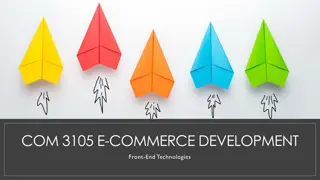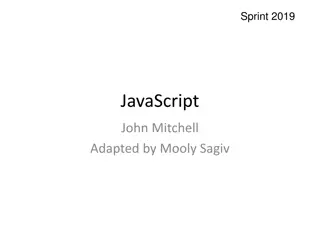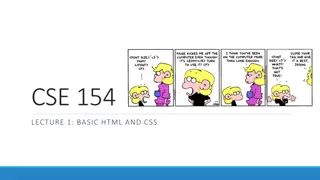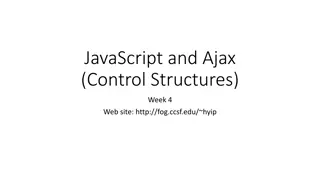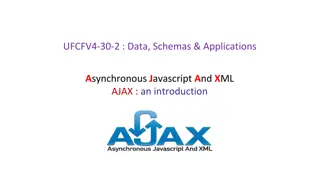
JavaScript AJAX
Explore the power of Asynchronous JavaScript and XML (AJAX) in updating web pages dynamically without full reloading. Learn about the typical AJAX procedure, XMLHttpRequest object methods, and examples of making HTTP requests. Enhance your web development skills with AJAX techniques explained by Dylan Schwesinger from Kutztown University's Computer Science Department.
Uploaded on | 3 Views
Download Presentation

Please find below an Image/Link to download the presentation.
The content on the website is provided AS IS for your information and personal use only. It may not be sold, licensed, or shared on other websites without obtaining consent from the author. If you encounter any issues during the download, it is possible that the publisher has removed the file from their server.
You are allowed to download the files provided on this website for personal or commercial use, subject to the condition that they are used lawfully. All files are the property of their respective owners.
The content on the website is provided AS IS for your information and personal use only. It may not be sold, licensed, or shared on other websites without obtaining consent from the author.
E N D
Presentation Transcript
JavaScript AJAX CSC 242 Professor John Carelli Kutztown University Computer Science Department
Asynchronous JavaScript And XML (AJAX) AJAX allows web pages to be updated asynchronously by making HTTP requests in the background AJAX facilitates updating parts of a web page without reloading the whole page AJAX is a method that relies on the XMLHttpRequest object (to make HTTP requests) and the JavaScript DOM Source Dylan Schwesinger Kutztown University Computer Science Department
Typical AJAX Procedure 1. A DOM event is fired 2. An XMLHttpRequest object is created as part of the event handler 3. The XMLHttpRequest object sends an HTTP request to a server 4. The server processes the request and sends a response back to the browser 5. The response is read by JavaScript and the DOM is updated accordingly Source Dylan Schwesinger Kutztown University Computer Science Department
The XMLHttpRequest Object Methods: new XMLHttpRequest() abort() getAllResponseHeaders() getResponseHeader() open(method, url, async, user, password) send() send(string) setRequestHeader(header, value) Properties: onreadystatechange readyState responseText Source Dylan Schwesinger Kutztown University Computer Science Department
XMLHttpRequest Example var xhttp = new XMLHttpRequest(); xhttp.onreadystatechange = function() { if (this.readyState == 4 && this.status == 200) { var node = document.getElementById("one"); node.innerHTML = this.responseText; } }; xhttp.open("GET", "file.txt", true); xhttp.send(); Source Dylan Schwesinger Kutztown University Computer Science Department
HTTP Requests The open() and send() methods are used to make an HTTP request open(method, url, async, user, password) method: type of request (GET or POST) url: the URL of the resource async: true (asynchronous) or false (synchronous) user: optional user name password: optional password An asynchronous request does not have to wait for the server s response Source Dylan Schwesinger Kutztown University Computer Science Department
The send Methods The send() method is intended for GET requests or POST requests with no URL query data var xhttp = new XMLHttpRequest(); xhttp.open("GET", "file.txt", true); xhttp.send(); The send(string) method is used to POST URL encoded data var xhttp = new XMLHttpRequest(); xhttp.open("POST", "login.php", true); xhttp.setRequestHeader("Content-type", "application/x-www-form-urlencoded"); xhttp.send("username=Bob&password=swordfish"); Source Dylan Schwesinger Kutztown University Computer Science Department
The setRequestHeader Method The setRequestHeader is used to add an HTTP request header setRequestHeader(header, value) header: specifies the HTTP header name value: specifies the HTTP header value Source Dylan Schwesinger Kutztown University Computer Science Department
The onreadystatechange Property The onreadystatechange defines a function to be called when the readyState changes The readyState property contains the status of the XMLHttpRequest 0: request not initialized 1: server connection established 2: request recieved 3: processing request 4: request finished and response is ready The status property contains the HTTP status code The statusText property contains the HTTP status text Source Dylan Schwesinger Kutztown University Computer Science Department
Retrieving the HTTP Response Data The responseText property contains the response data as a string The responseXML property contains the response as an XML DOM object The getResponseHeader(header name) method returns the value of a specific HTTP header The getAllResponseHeaders() method returns all of the HTTP response headers Source Dylan Schwesinger Kutztown University Computer Science Department
XMLHttpRequest Events readystatechange: the readyState property changes loadstart: progress has begun progress: in progress error: progression failed abort: progression is terminated timeout: progression is terminated due to preset time expiring load: progression is successful loadend: progress has stopped Source Dylan Schwesinger Kutztown University Computer Science Department
Abstracting XMLHttpRequests XMLHttpRequest code typically follows a standard pattern That pattern can be abstracted into a helper function to avoid writing the repetitive XMLHttpRequest handling code: function getURL(url, callback) { var req = new XMLHttpRequest(); req.open("GET", url, true); req.addEventListener("load", function() { if (req.status == 200) { callback(req.responseText); } }); req.send(); } Source Dylan Schwesinger Kutztown University Computer Science Department




